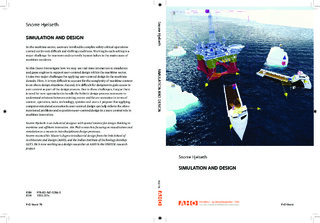Simulation and design
Doctoral thesis, Peer reviewed
Permanent lenke
http://hdl.handle.net/11250/2433549Utgivelsesdato
2016Metadata
Vis full innførselSamlinger
- Design [33]
Sammendrag
In this thesis, I investigate the use of simulation, game engines and real-time interaction in user-centred design for the maritime sector. In this sector, users are involved in complex safety critical operations carried out in very challenging and shifting conditions. This is a major challenge for workers and currently human failure is the main cause of maritime accidents.
To help relieve such problems, product and interaction design have traditionally applied a user-centred design approach. However, in the maritime sector, user-centred design approaches has only been used to a very limited extent. I raise two major challenges for applying user-centred design in maritime design. First, it is very difficult to account for the complexity of maritime context in on-shore design situations. Second, it is difficult for designers to gain access to user context as part of the design process.
Due to these challenges, I argue there is need for new approaches to handle the holistic design process necessary to understand relations between existing events and future scenarios in terms of context, operation, tasks, technology, systems and users. I propose that applying computer-simulated scenarios in user-centred design can help relieve the aforementioned problems and so position user-centred design in a more central role regarding innovation in the maritime sector.
Through several case studies of design projects in the maritime industry, I have researched the role of user-centred design in maritime innovation and have uncovered challenges that need to be addressed. In adopting a research by design approach, I have been able to implement new approaches using simulation in collaborative design sessions at the front end of innovation dealing with ideas and concepts. Game engines as both a platform and a meditational tool have been explored and analysed so as to represent, model and simulate boundary objects in real-time. I propose that there is a need to approach user-centred design in the maritime sector according to a ‘design in use time’ approach rather than a ‘design before use time’ approach. To do so I have used concepts and taxonomies from simulation in the natural and social sciences to develop a design-centred view on simulation. Such a design-centred view on simulation seeks to create a design space for exploration intended to reveal the issues, challenges, solutions and possibilities related to a particular context of use. I introduce two new models to support a design-centred view on simulations. The Contextual Simulation Space Model and the Contextual Simulation
Process Model. These models build on a combination of simulation, gamification and real-time interaction to describe context-related events and scenarios useable in collaborative design sessions with users and actors. I suggest that, when used as a simulation tool, the game engine functions as a platform connecting the different types of media used to construct scenarios. In addition, game engines offers game-related functions that also can be used in by designers to render user experiences. The use of game engine driven scenarios may help designers to work with complexity on multiple levels, which addresses the web of connections between context, operations, tasks, systems, technology and users. My analysis shows that we can use simulation to model the actions and behaviours of users together with the evolution of systems as a time-based method to immerse the designer ‘in use time’. I argue time element is vital when designing for safety and critical operations, and I show how simulation and gamification using real-time interaction can be used to manipulate time in the scenarios I have developed. Overall, the research can lead to a better understanding of simulation in usercentred design as well as how it can be developed further to address the safety and critical matters in other domains.
